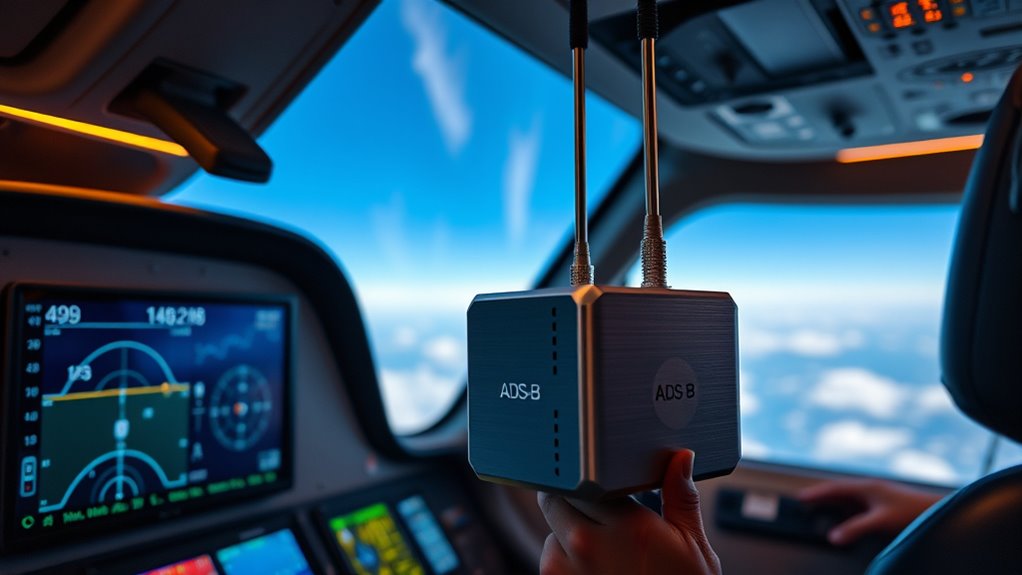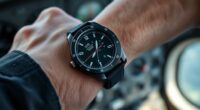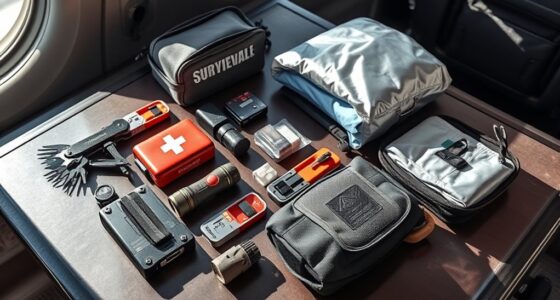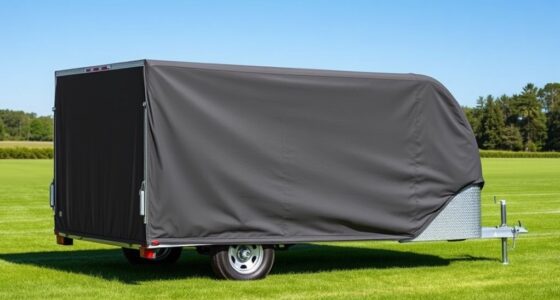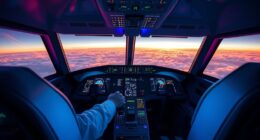If you’re looking to boost your flight safety and situational awareness in 2025, I recommend exploring the top ADS‑B receivers like the Stratux, Garmin GDL 50, PiAware, and Blue R820T2 SDR kits. These offer excellent portability, range, and compatibility with popular apps. Their features include dual-band support, reliable signal reception, and rugged designs for various environments. Keep going to discover more about how each option can help improve your flying experience.
Key Takeaways
- Top portable ADS-B receivers like Stratux, Garmin GDL 50, and PiAware offer reliable flight tracking and weather data for pilots in 2025.
- Advanced models feature dual-band support, extended range, and high-sensitivity antennas for improved signal reception in various environments.
- Compatibility with popular flight apps (ForeFlight, WingX) and connectivity options (WiFi, Bluetooth, USB) enhance seamless integration.
- Rugged, compact designs with weather-resistant features ensure durability for outdoor and mobile flight operations.
- Price ranges from budget-friendly SDR units to premium systems with GPS and AHRS, catering to different pilot needs and budgets.
Stratux ADS-B Dual Band Receiver for Aviation Weather and Traffic
If you’re a pilot looking for an affordable, portable ADS-B receiver that delivers reliable weather and traffic data, the Stratux ADS-B Dual Band Receiver is an excellent choice. Built on Raspberry Pi 3, it supports popular apps like ForeFlight, Garmin Pilot, and WingX via WiFi. It captures air-to-air traffic, FIS-B weather, METARs, TAFs, NOTAMs, and more, even in cloudy conditions thanks to external high-gain antennas. With a 10,000mAh battery, it provides over 5 hours of use. Its compact design, easy setup, and responsive customer support make it a versatile, cost-effective option for VFR and IFR pilots alike.
Best For: VFR and IFR pilots seeking an affordable, portable ADS-B receiver with reliable weather, traffic data, and easy WiFi connectivity.
Pros:
- Compact, portable design with easy setup and user-friendly interface.
- Supports multiple popular flight apps like ForeFlight, Garmin Pilot, and WingX via WiFi.
- External high-gain antennas enhance reception in cloudy or challenging conditions.
Cons:
- Occasional WiFi reconnection issues reported by some users.
- Calibration requires level flight, which may be tricky during certain maneuvers.
- Limited to approximately 5-6 hours of continuous use per battery charge.
AirNav Radar FlightStick ADS-B USB Receiver
The AirNav Radar FlightStick ADS-B USB Receiver stands out as an excellent choice for aviation enthusiasts and pilots who need a portable, high-performance flight tracking tool. Its compact size (just 3.54 x 0.79 x 0.39 inches) and lightweight design make it easy to carry and set up anywhere. With an integrated 1090 MHz band pass filter and in-built amplifier, it offers a 25-100% increase in reception range, ensuring clearer, more reliable data. Compatible with Raspberry Pi and Radarbox.com, it delivers real-time flight positions, altitude, speed, and more. Rated 4.4 stars, it’s a versatile, dependable device for tracking and enhancing your flying experience.
Best For: aviation enthusiasts, hobbyists, and pilots seeking a portable, high-performance flight tracking device compatible with Raspberry Pi.
Pros:
- Compact, lightweight design for easy portability and setup
- Enhanced reception range with integrated filter and amplifier for clearer data
- Compatible with Radarbox.com and Raspberry Pi for versatile usage
Cons:
- Requires some technical knowledge for setup and integration
- Limited to 1090 MHz frequency, which may not cover all tracking needs
- May be less suitable for users seeking a standalone, non-USB-based solution
Garmin GDL 50 Portable ADS-B Receiver
The Garmin GDL 50 Portable ADS-B Receiver stands out as an excellent choice for pilots seeking reliable traffic and weather updates in a compact, portable package. It offers dual-link ADS-B traffic, FIS-B weather, GPS, and backup attitude info, all displayed via Bluetooth on iPads, Android devices, and Garmin GPS units like Aera-660 and Aera-795. Easy to pair with CONNEXT and ready to use out of the box, it’s rugged and reliable for various flying environments. With quick GPS reception and seamless traffic detection, it enhances situational awareness. Although the mini-USB charging is outdated, its durability and compatibility make it a valuable tool for pilots wanting dependable traffic and weather info.
Best For: private pilots, flight instructors, and general aviation enthusiasts seeking reliable, portable traffic and weather information compatible with iOS and Android devices.
Pros:
- Easy to pair with Bluetooth via CONNEXT and ready to use out of the box
- Provides real-time traffic, weather updates, and backup attitude info for enhanced safety
- Durable, lightweight, and compatible with multiple Garmin and third-party EFB applications
Cons:
- Outdated mini-USB charging port; USB-C would be preferable
- Mounting can be awkward in certain aircraft like floatplanes or unique configurations
- Battery life of approximately 8 hours may be insufficient for longer flights
PiAware Dual Band ADS-B Ground Receiver
For pilots seeking reliable, wide-ranging aircraft detection, the PiAware Dual Band ADS-B Ground Receiver stands out with its support for both 1090 MHz and 978 UAT frequencies. This ground-based unit offers extensive coverage, detecting aircraft up to 150 nautical miles away with its high-gain antennas. It’s designed for easy setup—just plug in, configure WiFi, and start tracking—no complex configuration needed. Compatible with the FlightAware Flight Tracking Unit, it provides real-time aircraft data, enhancing situational awareness. With its dual-band capability and straightforward operation, the PiAware receiver is an excellent choice for pilots who want all-encompassing, reliable flight tracking.
Best For: pilots and aviation enthusiasts seeking reliable, wide-ranging aircraft detection with easy setup and dual-band coverage.
Pros:
- Supports both 1090 MHz and 978 UAT frequencies for comprehensive aircraft detection
- Detects aircraft up to 150 nautical miles away, offering extensive coverage
- Plug-and-play design with no complex configuration, enabling quick setup
Cons:
- Requires WiFi configuration on the microSD card, which may be challenging for some users
- Dependent on external power supply and antennas for optimal performance
- Limited to aircraft equipped with ADS-B transmitters within the specified range
ADSBexchange.com Blue R820T2 RTL2832U SDR Kit
Designed for serious pilots and aviation enthusiasts, the ADSBexchange.com Blue R820T2 RTL2832U SDR Kit offers superior signal reception with its onboard 1090 MHz filter and amplifier. Its aluminum case improves heat dissipation and reduces interference, while the included 21cm, purpose-built 5 dBi antenna ensures peak performance. The kit features a 0.5 PPM TCXO for stable frequency accuracy despite temperature changes, and it’s a drop-in replacement for the FlightAware Pro Stick Plus. Compatible with Raspberry Pi models and equipped with a rugged microSD card, this setup guarantees reliable, long-term operation even in demanding environments.
Best For: aviation enthusiasts and serious pilots seeking a reliable, high-performance ADS-B receiver with stable frequency accuracy and durable design for demanding environments.
Pros:
- Superior signal reception with onboard 1090 MHz filter and amplifier for extended range
- Stable frequency accuracy maintained by 0.5 PPM TCXO despite temperature variations
- Durable aluminum case and rugged microSD card ensure long-term reliable operation in challenging conditions
Cons:
- Requires USB-C power supply, which may necessitate additional accessories for some setups
- Compatibility limited to Raspberry Pi models, limiting flexibility with other hardware platforms
- Slightly higher cost compared to basic SDR receivers due to advanced features and robust construction
Nooelec NESDR Mini USB RTL-SDR & ADS-B Receiver Set
If you’re seeking an affordable yet reliable ADS-B receiver for your SDR setup, the Nooelec NESDR Mini USB RTL-SDR & ADS-B Receiver Set stands out. It features the RTL2832U interface IC and R820T tuner IC, delivering enhanced sensitivity and selectivity. The package includes a no-nonsense USB dongle and antenna, with an MCX input for straightforward setup. Designed for SDR applications, it outperforms generic options with its high-quality components. Plus, it’s ESD-safe and backed by a full 1-year warranty. Whether you’re a beginner or experienced pilot, this set offers reliable performance and easy integration for your flight tracking needs.
Best For: hobbyists and aviation enthusiasts seeking an affordable, reliable ADS-B receiver for flight tracking and SDR projects.
Pros:
- Enhanced sensitivity and selectivity with high-quality RTL2832U and R820T components
- Easy setup with MCX input and included antenna, suitable for beginners and experienced users
- Durable and protected against electrostatic discharge, backed by a 1-year warranty
Cons:
- Limited to SDR applications and may require additional software configuration
- May have performance limitations in extremely crowded or weak signal environments
- The included antenna might need upgrading for optimal signal reception in certain locations
Nooelec NESDR Mini USB RTL-SDR & ADS-B Receiver Set
The Nooelec NESDR Mini USB RTL-SDR & ADS-B Receiver Set stands out as an excellent choice for pilots seeking a versatile, budget-friendly ADS-B receiver. It features a high-quality RTL2832U interface IC and R820T tuner IC, providing improved sensitivity and signal clarity. The package includes a USB dongle with an MCX input and a reliable antenna, making setup straightforward. Its durable, ESD-safe design guarantees longevity during frequent use. Compatible with various SDR software, this set offers flexible, cost-effective performance. Plus, with a full 1-year warranty and support, it’s a practical choice for pilots wanting reliable ADS-B data without breaking the bank.
Best For: pilots and aviation enthusiasts seeking a cost-effective, reliable ADS-B receiver for real-time flight data and signal clarity.
Pros:
- High-quality RTL2832U interface IC and R820T tuner IC for improved sensitivity and signal reception
- Includes a durable, ESD-safe design and a reliable antenna for long-term use
- Compatible with various SDR software packages for versatile application
Cons:
- May require some technical knowledge for setup and configuration
- Limited to the included antenna unless additional accessories are purchased
- Performance can be affected by interference in congested environments
Nooelec NESDR Mini 2 USB RTL-SDR and ADS-B Receiver Set
For pilots seeking an affordable yet high-performance ADS-B receiver, the Nooelec NESDR Mini 2 USB RTL-SDR set stands out as an ideal choice in 2025. Its compact design packs impressive sensitivity and a wide frequency range from 24MHz to 1750MHz, perfect for capturing ADS-B signals. The upgraded components, including a high-quality telescopic antenna, ensure clearer reception compared to older models. Compatibility with popular SDR software like SDR#, HDSDR, and MATLAB makes it versatile for both beginners and advanced users. Plus, with a one-year warranty and positive reviews, this set offers reliable performance at a budget-friendly price.
Best For: pilots and aviation enthusiasts seeking an affordable, high-performance ADS-B receiver with wide frequency coverage and reliable signal reception.
Pros:
- High sensitivity and excellent reception due to upgraded internal components and telescopic antenna.
- Wide frequency range from 24MHz to 1750MHz, suitable for ADS-B and other signals.
- Broad software compatibility including SDR#, HDSDR, and MATLAB, accommodating both beginners and advanced users.
Cons:
- May require additional accessories like upconverters for listening below 25MHz.
- Slightly larger dimensions compared to ultra-compact SDR devices, which could affect portability.
- Limited to the capabilities of the RTL2832U demodulator, which may not match more expensive, specialized SDRs for certain advanced applications.
QRP Z-Match Manual Antenna Tuner 3-28 MHz for HAM Radio
The QRP Z-Match Manual Antenna Tuner 3-28 MHz is an excellent choice for amateur radio enthusiasts who need a compact, durable tuner capable of handling high-impedance and low-loss connections. It’s compatible with a wide range of antennas, including coaxial fed, long wire, and balanced line types, making it versatile for various setups. Rated at 5 watts continuous and 10 watts intermittent, it features BNC connectors for easy integration. Its metal housing ensures durability for outdoor use, and its high Q design offers efficient performance with minimal losses. Keep in mind, it’s suitable only for ORP and can be damaged by excessive power.
Best For: amateur radio operators seeking a compact, durable, and efficient manual antenna tuner compatible with various antenna types and capable of handling high-impedance, low-loss connections.
Pros:
- Compatible with a wide range of antennas including coaxial fed, long wire, and balanced line types
- High Q design ensures efficient performance with minimal losses
- Durable metal housing suitable for outdoor use
Cons:
- Limited power handling of only 5 watts continuous and 10 watts intermittent
- Suitable only for ORP, restricting its use in other configurations
- Can be damaged by excessive power beyond rated specifications
QRP Manual Antenna Tuner Z-Match 3-28MHz for Ham Radio CW
Looking for a compact and reliable antenna tuner that can handle your ham radio CW operations across a wide frequency range? The QRP Manual Antenna Tuner Z-Match 3-28MHz is perfect. It supports 3 to 28 MHz, handling up to 5W continuous power, with a 10W intermittent limit. Equipped with BNC connectors, it works with various antennas like coaxial, long wire, and ladder line. Its intuitive front panel switch toggles between tuning and operating modes, and adjustable capacitors help achieve a proper match. Weighing only 261g and built for outdoor use, it’s a portable, efficient tool for ham radio enthusiasts seeking reliable impedance matching.
Best For: ham radio enthusiasts and CW operators seeking a compact, reliable, and versatile antenna tuner for low-power outdoor use across 3-28 MHz.
Pros:
- Supports a wide frequency range of 3-28 MHz with impedance matching from 25 to 2500 ohms.
- Lightweight and compact design weighing only 261g, ideal for portable and outdoor operation.
- Easy to operate with intuitive front panel switch and adjustable capacitors for quick tuning.
Cons:
- Limited to 5W continuous and 10W intermittent power, not suitable for high-power applications.
- Tuning may require additional tools like a network analyzer if quick matches are difficult to achieve.
- LED indicator may not fully extinguish, potentially causing confusion during tuning.
ATU-130 Antenna Tuner for HAM Radio
If you’re a ham radio enthusiast, preppers, or field operator seeking reliable and versatile antenna tuning, the ATU-130 Antenna Tuner stands out as an excellent choice. It covers 1.8 to 50 MHz, supporting various antennas like long wires, dipoles, and end-fed setups. Its automatic, instant tuning works across modes, even high-SWR scenarios, with power handling up to 150W continuous and 200W peak. Built with durable aluminum alloy and high-quality components, it stays cool and offers protection during demanding use. Its compact size, OLED display, and easy operation make it perfect for home, vehicle, or field operations, ensuring top-notch performance wherever you go.
Best For: ham radio enthusiasts, preppers, and field operators seeking reliable, versatile antenna tuning for various setups and modes.
Pros:
- Supports a wide frequency range of 1.8-50MHz with fast SWR matching for multiple modes including FT8, CW, FM, and SSB
- Built with durable high-quality components and aluminum alloy shell, ensuring heat dissipation and longevity during extended use
- Automatic, instant tuning without external control lines simplifies setup and operation in home, mobile, or field environments
Cons:
- Limited to a maximum power handling of 150W continuous, which may not suit high-power station needs
- Slightly larger dimensions compared to ultra-compact models, potentially affecting portability for some users
- Requires a 10-15VDC power supply, which may need additional setup for field or mobile use
ADS-B Antenna 1090MHz 978MHz | N-Type Female | Omnidirectional Fiberglass Indoor/Outdoor High Gain 6dBi
For pilots seeking reliable signal reception across various environments, the ADS-B Antenna 1090MHz 978MHz withconnector offers exceptional versatility. Its omnidirectional fiberglass design guarantees consistent performance whether indoor or outdoor, capturing signals from all directions. With a high gain of 6dBi, it extends detection range, helping you see more aircraft at greater distances. The durable construction features a black radome and copper internal tubing for durability and better signal quality. Comes with a 10-meter coaxial cable and mounting hardware, making installation flexible. This antenna is compatible with most SDRs and flight tracking software, boosting your situational awareness effectively.
Best For: Aviation enthusiasts, aircraft spotters, and pilots seeking reliable, long-range signal reception for aircraft tracking in various indoor and outdoor environments.
Pros:
- Omnidirectional fiberglass design ensures consistent signal reception from all directions.
- High gain of 6dBi extends detection range and improves data accuracy.
- Durable construction with copper tubing and weather-resistant radome for outdoor use.
Cons:
- Requires proper placement in high outdoor locations for optimal performance.
- Installation may be challenging in obstructed or urban environments.
- Length of coaxial cable (10 meters) might be excessive or insufficient depending on setup needs.
Mygica A681B USB 2.0 TV Tuner Card
The Mygica A681B USB 2.0 TV Tuner Card stands out as an affordable and portable option for users who want to watch live digital TV on their desktops, laptops, or Android devices. It supports 1080P HDTV, recording, and playback with HiDTV software, making it versatile for different platforms. Compatible with Windows 7, 10, 11, Linux Ubuntu, Android TV, and Android car systems, it’s ideal for regions like the US, Canada, and South Korea. Weighing just 4.2 ounces, it’s compact and easy to carry. While setup can be tricky due to driver issues, it offers good reception in open areas, especially with an external antenna.
Best For: budget-conscious users seeking a portable and versatile digital TV tuner compatible with Windows, Android, and Linux systems who are willing to troubleshoot driver and software issues.
Pros:
- Affordable and lightweight, making it highly portable for travel and outdoor use
- Supports high-definition 1080P HDTV for clear viewing and recording
- Compatible with multiple platforms including Windows, Android, and Linux
Cons:
- Difficult driver installation and frequent compatibility issues, especially on Windows 11
- Outdated software like HiDTV can cause recording and channel management problems
- Tends to overheat during extended use, requiring external cooling solutions
Mygica A681B Analog USB TV Tuner Card
The Mygica A681B Analog USB TV Tuner Card stands out for users who want to experiment with basic TV reception on Windows, Linux, or Android devices without relying on WiFi. It’s an external device that captures analog signals through an antenna and supports 1080P HDTV playback and recording. Setup requires downloading drivers and software, which can be tricky, especially on Windows 11. The included small antenna offers limited reception, often needing upgrades for better performance. The hardware and software are outdated, with unstable connections and frequent crashes, making it more suitable for occasional or experimental use rather than everyday TV watching. Overall, it’s a niche tool with limited future-proofing.
Best For: users interested in experimenting with basic analog TV reception on Windows, Linux, or Android devices without expecting modern features or ease of use.
Pros:
- Supports 1080P HDTV playback and recording via HiDTV software
- Compatible with multiple operating systems including Windows, Linux, and Android TV
- Small, portable external design suitable for occasional use
Cons:
- Outdated hardware and software with frequent crashes and unreliable performance
- Difficult driver installation, especially on Windows 11, often requiring workarounds
- Limited reception with included antenna, necessitating upgrades for better signal quality
Factors to Consider When Choosing Ads‑B Receivers for Pilots
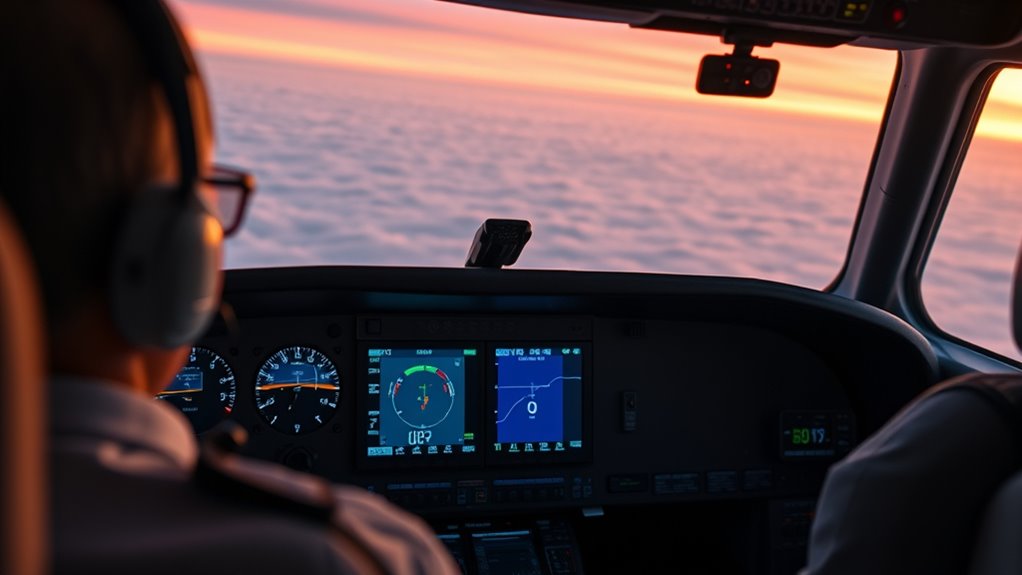
When choosing an ADS‑B receiver, I consider factors like signal range and quality to guarantee reliable reception. Compatibility with my devices and portability also matter, making setup quick and hassle-free. Additionally, I look at weather resistance and power needs to keep my setup stable and ready in all conditions.
Signal Range and Quality
Choosing an ADS-B receiver with strong signal range and quality is indispensable for reliable aircraft detection, especially over long distances. The range depends heavily on antenna quality, placement, and environmental factors, affecting how many aircraft I can see at once. High-gain, external antennas can extend reception beyond 100 miles in open areas, which is essential for long-range awareness. Signal quality is equally important; it’s influenced by frequency filtering, amplifier performance, and cable shielding. A receiver with onboard filtering and amplification, like a dedicated ADS-B filter, helps improve data clarity by reducing interference. Additionally, a stable power supply and proper grounding are critical for consistent, high-quality signals. These factors ensure I get accurate, reliable data, enhancing safety and situational awareness during flights.
Compatibility With Devices
Ensuring your ADS-B receiver is compatible with your device’s operating system and connectivity options is essential for seamless integration. I always check if the receiver supports iOS, Android, Windows, or Linux, depending on my device. It’s also important to verify that it supports the specific data bands I need, like 1090 MHz or 978 MHz UAT. Connectivity methods matter too—whether via WiFi, Bluetooth, USB, or dedicated antennas—so I confirm my device has the right ports and preferences. Additionally, I review the hardware specs to guarantee my device can handle the receiver’s processing and storage needs. Finally, I look at manufacturer info to confirm the receiver’s firmware and software are compatible with my preferred aviation apps and data systems. Compatibility is key to smooth operation.
Portability and Setup Ease
Portability and setup ease are essential factors that can make or break your experience with an ADS-B receiver. A compact design with rechargeable batteries allows me to use it both in the cockpit and on the ground without fuss. Simple, plug-and-play hardware means I can get it running quickly with minimal configuration, saving time and frustration. External antennas and easy mounting options like suction cups or portable stands improve signal reception without complex installation. WiFi or Bluetooth connectivity simplifies data sharing, letting me access weather and traffic info on multiple devices effortlessly. Its lightweight, small form factor makes packing and deploying fast, fitting easily into different aircraft and environments. Overall, these features ensure a hassle-free setup, so I can focus on flying rather than troubleshooting.
Power Supply Requirements
When selecting an ADS-B receiver, it’s crucial to verify that its power supply matches your aircraft’s electrical system, which is typically 12V or 24V DC. Some units draw power directly from USB or AV ports, while others require an external power source. Make sure the receiver’s voltage and current ratings align with your aircraft’s electrical specifications to guarantee reliable operation without risking electrical issues. Check if the device has built-in power management features or protections against power surges and voltage fluctuations. For portable or standalone receivers with rechargeable batteries, confirm that their charging requirements are compatible with your power circuitry. Matching the power supply needs helps maintain safety, performance, and longevity of your ADS-B receiver during flights.
Weather Resistance Features
Weather resistance is a critical factor when choosing an ADS-B receiver, especially since pilots often fly through diverse and unpredictable conditions. I look for devices with sealed enclosures and corrosion-resistant materials that can handle rain, snow, and humidity without fail. External antennas with waterproof connectors and weatherproof housings are essential to maintain signal integrity in adverse weather. Devices rated with IP ratings, like IP65 or higher, give me confidence they’re protected against dust and water intrusion during outdoor use. Ruggedized mounting hardware and sealed ports help prevent moisture from damaging internal electronics. Additionally, features like proper ventilation and heat dissipation are indispensable to avoid condensation inside the unit when temperatures fluctuate. Overall, weather-resistant design ensures reliability and durability in all flying conditions.
Cost and Budget Limits
Choosing an ADS-B receiver within your budget requires careful consideration of both upfront costs and long-term expenses. Prices vary widely, from around $20 for basic SDR units to over $1,000 for premium models with advanced features. Budget-conscious pilots often choose lower-cost SDR dongles and antennas, but these may require extra setup and calibration. Higher-priced receivers generally offer better signal sensitivity, durability, and integrated features like GPS or AHRS, which can enhance your flying experience. When evaluating costs, consider not just the device itself but also accessories like antennas, mounting gear, and power supplies. Establishing a clear budget helps you focus on options that meet your needs without overspending, ensuring you get the best value for your investment.
Frequently Asked Questions
What Is the Maximum Range for Effective ADS-B Signal Reception?
The maximum range for effective ADS-B signal reception is typically around 250 miles (400 km) in open areas, but it can vary depending on terrain, altitude, and receiver quality. I’ve found that flying at higher altitudes improves reception, sometimes extending range beyond 250 miles. However, obstacles like mountains or buildings can reduce this distance considerably. So, to get the best coverage, I recommend a good receiver and flying at higher altitudes when possible.
How Do Weather Conditions Impact ADS-B Receiver Performance?
Weather conditions can substantially impact ADS-B receiver performance. When there’s heavy rain, snow, or thunderstorms, signals may weaken or become unreliable due to signal attenuation or interference. I’ve noticed that fog and clouds tend to have less effect, but extreme weather definitely decreases reception quality. To guarantee safety, I always check weather forecasts and consider signal quality during adverse conditions, as my receiver’s performance can vary with weather.
Can These Receivers Integrate With Existing Cockpit Avionics Systems?
Yes, many ADS-B receivers can integrate with existing cockpit avionics systems, but compatibility varies. I always check the receiver’s specifications and your aircraft’s avionics before purchasing. Modern units often feature seamless integration via standard protocols like ARINC or Ethernet, which helps streamline your cockpit. Just remember, some setups might require additional interfaces or upgrades, so it’s wise to consult with a professional to guarantee smooth integration.
What Are the Power Consumption Differences Between Portable and Fixed Units?
Portable ADS-B receivers typically consume less power, making them ideal for quick setups and battery-powered use. Fixed units, however, often require more power due to their advanced processing capabilities and constant connection to aircraft systems. I’ve noticed that while portable units are energy-efficient and convenient, fixed installations provide more stability and consistency, especially on longer flights. It’s all about balancing power needs with your specific flight requirements.
Are There Firmware Updates Available for Improved Feature Support?
Absolutely, firmware updates are available and often bring exciting new features, much like upgrading a trusted compass to navigate clearer skies. I regularly check with manufacturers’ websites or apps to guarantee my device is up-to-date. These updates improve performance, fix bugs, and sometimes add functionalities. Staying current with firmware is essential for peak operation, giving me confidence that my ADS‑B receiver is always ready for safe and efficient flying.
Conclusion
So, there you have it—your ticket to becoming the coolest pilot on the block with the latest ADS-B gear. Whether you’re chasing weather, traffic, or just impressing your friends with tech wizardry, one thing’s clear: the sky’s the limit—and now your receiver’s got it covered. Just remember, with all this high-tech stuff, you might finally outshine your plane’s engine. Safe flying, and happy surfing the friendly skies!
